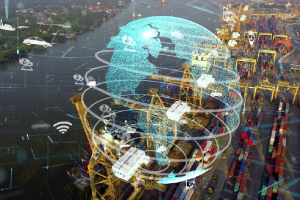Why Supply Chain Resilience Matters More Than Ever
In today’s unpredictable logistics environment, supply chain disruptions are a constant challenge rather than a rare occurrence. Factors ranging from the COVID-19 pandemic to the ongoing effects of the Russia-Ukraine conflict have created significant geopolitical instability and unsettling global commerce. As we look ahead to 2025, renewed tensions between the U.S. and China, particularly concerning technology exports and Taiwan, are leading to increased tariffs and disruptions in semiconductor supply chains (OECD, 2025). At the same time, North American trade is undergoing significant changes, driven by negotiations around USMCA standards and a push for closer supply chain integration among the U.S., Canada, and Mexico. Additionally, ongoing Houthi attacks in the Red Sea and changes in port security protocols are causing shipments to reroute through longer, more expensive shipping lanes.
According to McKinsey, disruptions lasting more than a month now happen every 3.5 years on average, with their increasing frequency linked to climate-related events and geopolitical tensions. The pandemic initially triggered a 400% surge in ocean freight rates, highlighting the fragility of overcentralized supply models, which many companies are now working to decentralize (OECD, 2024). For businesses focused on continuity, efficiency, and customer satisfaction, investing in a resilient supply chain has become essential, not optional. Partnering strategically with a third-party logistics (3PL) provider, such as Direct Traffic Solutions, offers more than just outsourced transportation; it provides critical infrastructure for risk mitigation, operational agility, and cost control. In this post, we will analyze the current geopolitical and economic landscape, identify systemic risks, and demonstrate how the right 3PL can serve as the foundation of a modern, adaptable supply chain.
Navigating a Shifting Global Landscape

Forward-looking fleets now recognize that supply chain fragility is not a fleeting concern; rather, it is a defining characteristic of 21st-century commerce. According to Gartner, by 2026, 95% of companies will fail to achieve end-to-end supply chain resilience, reflecting chronic underinvestment in strategic adaptation. Meanwhile, only 21% of global supply chain leaders report having mature risk management frameworks in place.
OECD policy briefs emphasize the importance of regional sourcing, investing in innovative logistics platforms, and leveraging scalable third-party logistics (3PL) partnerships to reduce systemic exposure (OECD, 2024). Without these adaptations, companies remain vulnerable to port closures, cyberattacks, capacity imbalances, sanctions, and rapidly evolving regulatory environments.
The 2025 Outlook: Geopolitical and Economic Disruptions
The logistics outlook for 2025 highlights various intensifying challenges:
- Geopolitical Tensions: Ongoing volatility in U.S.-China trade relations, new EU customs protocols, and disruptions to shipping routes in the Red Sea are prompting supply chain leaders to rethink global trade strategies. Eighty-five percent of executives report restructuring their networks in response to this instability.
- Post-Pandemic Logistics Inflation:S. logistics costs surged to $2.6 trillion in 2024, representing 8.7% of GDP. Projections for 2025 indicate an additional increase of 7-10%, driven by labor shortages, fuel price volatility, and rising insurance premiums (OECD, 2024).
- Cold-Chain Expansion: The pandemic has increased demand for biologics and temperature-sensitive goods. As a result, the cold-chain logistics sector is projected to grow from $324 billion in 2024 to $862 billion by 2032, according to Fortune Business Insights (2024).
- Technological Acceleration: Investment in artificial intelligence (AI) and predictive analytics is soaring, with 90% of logistics executives prioritizing digital visibility and automation in 2025. The adoption rate of these technologies has nearly doubled compared to five years ago.
Trends Defining the New Era:
- Regionalization Over Globalization: Risk-averse companies are increasingly nearshoring production and diversifying their suppliers to mitigate the risks associated with regional instability.
- Digital & Autonomous Logistics: Innovations such as blockchain for traceability and robotic warehousing enhance supply chain precision and resilience through digitization.
- Sustainability Mandates: Environmental, social, and governance (ESG) policies now demand measurable reductions in emissions, pushing fleets to adopt cleaner technologies.
- Labor Disruption: The U.S. is facing a truck driver shortage of over 80,000, which is accelerating the shift towards automation and gig-based delivery models (ATA, 2024).
Strategic Challenges & 3PL-Driven Solutions

1. Visibility & Control
Challenge: Fragmented data silos hinder real-time decision-making.
3PL Advantage: Direct Traffic Solutions provides unified visibility tools, predictive insights, and real-time alerts, enabling up to 40% faster issue resolution and improved adherence to service level agreements (SLAs).
2. Freight Cost Volatility
Challenge: Rising costs due to inflation, shortages, and mismatched transportation modes.
3PL Advantage: Direct Traffic Solutions utilizes network optimization, volume contracts, and artificial intelligence (AI) to reduce freight spending by up to 20%.
3. Regulatory Complexity
Challenge: New trade regimes and shifting compliance norms increase operational risks.
3PL Advantage: Direct Traffic Solutions leverages in-depth trade expertise and adaptable standard operating procedures (SOPs) to ensure 100% audit readiness, resulting in a 25% reduction in compliance penalties.
4. Disruption Scalability
Challenge: Static networks struggle with demand spikes and SKU proliferation.
3PL Advantage: The elastic carrier model at Direct Traffic Solutions supports seamless scaling across markets and during peak seasons.
5. Cybersecurity Exposure
Challenge: Logistics-related cyberattacks increased by 68% in 2024, targeting Transportation Management Systems (TMS), Warehouse Management Systems (WMS), and customer portals (OECD, 2024).
3PL Advantage: Direct Traffic Solutions implements ISO-compliant frameworks, endpoint encryption, and real-time monitoring across all platforms to enhance cybersecurity.
Futureproofing Through Strategic Partnership

Building resilience is not something we do only in a crisis; it requires foresight and collaboration to achieve. With rising geopolitical risks, inflation-altering cost structures, and digitalization transforming how we operate, partnering with a strategic third-party logistics provider like Direct Traffic Solutions is essential for efficiency and survival.
Are you ready to future proof your supply chain? Connect with DTS to develop a customized logistics strategy that prioritizes resilience, speed, and cost-effectiveness.
Contact us today and make this season your most efficient yet!














